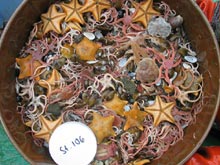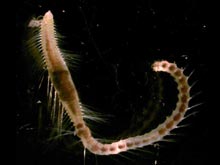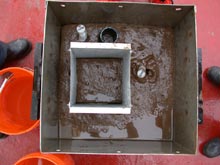
Bottom trawl treasures from the Chukchi Sea shelf near the Canada Basin: Sea stars, brittle stars, clams, some snails and crabs. Click image for larger view.
Bristle worm collected with a box core during the 2002 Arctic Ocean Exploration cruise. Click image for larger view.
Deep Sea Fauna
Bodil Bluhm
Research Assistant Professor
School of Fisheries and Ocean Sciences
University of Alaska
Katrin Iken
Assistant Professor Marine Biology
School of Fisheries and Ocean Sciences
University of Alaska Fairbanks
Life at the Arctic Deep Sea Floor
Early marine researchers assumed the deep-sea floor to be devoid of
any life. We now know that this is not true and that the diversity of species
living in the deep-sea may rival that in tropical coral reefs. At first,
scientists found the co-existence of manifold species puzzling because
they believed that the deep sea was rather homogeneous and harsh; it therefore
seemed logical that little variety of creatures would settle and survive
there. Today, we think that the small-scale heterogeneity caused by sand
ripples, animal tracks and worm burrows may partly explain the high richness
of species that more and more researchers are finding at 5,000 feet and
beyond. The arctic deep-sea, however, has received much less attention
than other deep areas of the ocean world.
Arctic and deep-sea animals have adapted to permanently low temperatures in various ways. One adaptation is that their body processes, such as respiration and reproduction, work at a slower rate than those of organisms in warmer waters. This does not mean that deep-sea organisms do not do as well as organisms from warmer waters. Rather, these animals' body chemicals and life-maintaining processes work best at ambient low temperatures and at high pressure. Most deep-sea organisms would die in tropical temperatures or if they were kept in an aquarium. A consequence of the slow 'rate of living', deep-sea and Arctic animals tend to grow very slowly. In fact, some arctic deep-sea organisms grow as much in 10 years as some tropical organisms grow in one year! Slow growth usually also means high longevity. A polar sea urchin can get as old as your grandparents, but a tropical one would likely die before its 10th birthday.
High longevity, slow growth and late reproduction are partly
consequences of low temperatures, but food also plays a very important
role. Sea floor animals depend primarily on food particles that rain down
from the top of the water column where microscopic algae, the bottom of
the so-called food web, grow and provide a rich food source. A good portion
of these algae are eaten by animals in the upper water column, leaving
the deep-sea creatures with what little is left over or with fecal pellets
and molts of those animals at the ocean surface. The food that does reach
the seafloor often is no longer fresh and has lost much of its nutritional
value. Moreover, ice-covered areas get less algal production than non-ice-covered
areas, resulting in even less “food rain” for the Arctic deep-sea
benthos. As a result, many deep-sea animals, especially bristle worms,
ingest sediment and extract whatever organic matter is left within it.
What we learned during the 2002 Arctic Ocean Exploration
cruise
During the 2002 cruise, we mainly explored the infaunal community at
the Arctic deep-sea floor, or those animals living within the sediment.
This community was dominated by polychaetes (bristle worms) as is typical
for most soft bottom regions of the world oceans. Other groups found
were bivalves and crustaceans of various sorts. Among the crustaceans,
we discovered at least three new species of isopods (crustaceans related
to pill bugs). Overall, the density and biomass of the infaunal animals
was low which again is typical of deep-sea areas elsewhere. The species
richness (number of species), however, was rather high and was dominated
by species of Atlantic origin even at sites geographically closer to
the Pacific. This phenomenon is caused by the bathymetry (depth of the
ocean floor) and history of the Arctic. Today's connection of the Arctic
to the Pacific, the Bering Strait, is shallow (only 50m or 150 feet),
so that deep-water species cannot pass it. In contrast, there has been
a deep-water connection to the Atlantic throughout the history of the
Arctic, so that species from the deep Atlantic could migrate into the
Arctic when conditions were right.
On a few occasions during the 2002 cruise, we were able to
put an 'eye in the sea' to look at the large benthic (sea floor) fauna
living on top of the sediment. The footage recorded by the remotely operated
vehicle showed that filter-feeding groups such as ascidians, feather stars
and cnidarians seemed to prefer the particle- and current-rich areas while
few large-bodied species occurred in the motionless, muddy central basin.
Since none of these specimens could be collected and few observations could
be made, we will focus the effort of the 2005 cruise on the large megafauna
species.
Our Goals for This Cruise
Our first expedition to the Canada Basin in 2002 allowed a glimpse into what
lives at the Arctic deep-sea floor and what the fauna survives on in terms
of food. As so often in science, every expedition inspires more questions than
it produces answers. We are excited to have another opportunity this year to
visit one of the most unexplored sea areas and try to find answers to our questions.
During our second Arctic Ocean Exploration expedition, the benthos
group aims to identify how habitat features affect species distribution
and richness at the Arctic deep-sea floor, and whether habitat heterogeneity
may be a driver of biodiversity. What are the discriminating species
at the abyssal plain versus the steep continental slopes? Why could
that be? To look at these questions, we hope to observe, collect,
quantify and identify the Arctic deep-sea megafauna, which are comprised
of the animals large enough to be seen on photographs of the seafloor.
We will use two photographic tools: a newly-designed photo platform
that can reach even the deepest parts of the Canada Basin at over
10,000 feet as well as a remotely operated vehicle with a collection
arm for shallower and intermediate stations. Although highly challenging
in the deep-sea and in ice, we will try to deploy a trawl net to
actually - for the first time - collect the larger benthic fauna
including the fishes from this area. Why is deployment challenging?
At 10,000 feet water depth, about 30,000 feet of cable are needed
to run a trawl - an operation that can require 10 hours, enough ice-free
area to operate in and a highly skilled crew. Let's see if we get
lucky. If trawling will not work, we will deploy a box core to collect
more infaunal organisms.
Our second goal is to improve our understanding of the food web of the high Arctic. As described above, food can be scarce in the high Arctic, and we are therefore curious what food resources different species exploit. A collection of video observations, stomach content analysis and naturally occurring isotopes will serve as our tools. We hope to trace food sources and follow organic matter flowing through the realms of the water column, the sea ice and benthos. The results will tell us which species feed on relatively fresh material (good quality food), which feed on other animals, and which survive on old, reworked detritus (bad quality food). The food web analysis of a whole ecosystem will help us identify key players as well as environmental key factors in the largely unexplored Arctic deep-sea ecosystem.
This expedition contributes to the Arctic Ocean Diversity project (ArcOD) ![]() of the International Census of Marine Life
of the International Census of Marine Life ![]() .
.



































